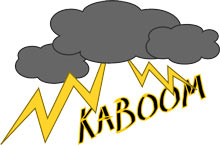SCIENCE FACTS
· The intense heat from lightning causes the
surrounding air to rapidly expand and create a sonic wave that you hear as
thunder.
· The average temperature of lightning is around 20000 °C (36000 °F).
· The sound of thunder can be anything from a loud crack to a low rumble.
· Light travels faster than sound so we see lightning before we hear thunder.
· The speed of sound is around 767 miles per hour (1,230 kilometres per hour).
· The speed of light is around 669600000 miles per hour (1080000000 kilometres per hour).
· Thunder is difficult to hear at distances over 12 miles (20 kilometres).
· Thousands of years ago philosophers such as Aristotle believed that thunder was caused by the collision of clouds.
· Astraphobia is the fear of thunder and lightning.
CLOUD
A cloud is a large group of tiny
water droplets that we can see in the air.
Clouds are formed when water on Earth evaporates
into the sky and condenses high up in the cooler air. Learn more about the
water cycle.
.Clouds can contain millions of tons of water.
Clouds can also be made of other chemicals.
Other planets in our Solar System have clouds.
Venus has thick clouds of sulfur-dioxide
while Jupiter and Saturn have clouds of ammonia.
THUNDER
· The average temperature of lightning is around 20000 °C (36000 °F).
· The sound of thunder can be anything from a loud crack to a low rumble.
· Light travels faster than sound so we see lightning before we hear thunder.
· The speed of sound is around 767 miles per hour (1,230 kilometres per hour).
· The speed of light is around 669600000 miles per hour (1080000000 kilometres per hour).
· Thunder is difficult to hear at distances over 12 miles (20 kilometres).
· Thousands of years ago philosophers such as Aristotle believed that thunder was caused by the collision of clouds.
· Astraphobia is the fear of thunder and lightning.
· The Oklahoma basketball team that play in the
National Basketball Association (NBA)are called the Thunder.
LIGHTNING
·
Lightning is a powerful burst of electricity
that happens very quickly during a thunderstorm.
·
Lightning is caused by an electrical charge in
the atmosphere that is unbalanced.
·
The movement of rain and ice inside a
thundercloud creates an electrical charge, with the negative charge (electrons)
forming at the bottom of the cloud and the positive charge (protons) forming at
the top.
·
Opposites attract so the negative charge at the
bottom of the cloud seeks out a positive charge to connect with.
·
Lightning can occur inside clouds,
between clouds and from clouds to the ground.
·
Direct lightning strikes are usually fatal.
·
Lightning rods (also called conductors) are
metal rods or similar objects that divert lightning safely to the ground, they
can often be seen at the top of tall buildings.
·
Most lightning occurs over land rather than
oceans, with around 70% of it occurring in the Tropics.
·
Lightning strikes usually last around 1 or 2
microseconds.
·
Lightning contains millions of volts of
electricity.
·
Thunder is the sound caused by lightning. Read our
thunder
facts for more.
·
The average temperature of lightning is around
20000 °C (36000 °F).
·
The study of lightning is known as fulminology.
·
HURRICANE
·
Other names for a hurricane include cyclone,
typhoon and tropical storm.
·
Hurricanes usually form in tropical areas of the
world.
·
Hurricanes develop over warm water and use it as
an energy source.
·
Hurricanes lose strength as they move over land.
·
Coastal regions are most at danger from
hurricanes.
·
As well as violent winds and heavy rain,
hurricanes can also create tornadoes,
high waves and widespread flooding.
·
Weather in the eye of a hurricane is usually
calm.
·
Hurricanes can be tracked by weather satellites
and weather radar closer to land.
·
Hurricanes have led to the death of around 2
million people over the last 200 years.
·
The 1970 Bhola Cyclone that struck Bangladesh
killed over 300000 people.
·
In 2005 Hurricane Katrina killed over 1800
people in the United States and caused around $80 billion dollars worth of
property damage. The city of New Orleans was hit particularly hard with levee
breaches leading to around 80% of the city being flooded.
WIND
·
Wind is the flow of gases, here on Earth it
refers to the movement of air.
·
It is caused by differences in air pressure. Air
rushes from high pressure areas to lower ones.
·
Short bursts of wind moving at high speeds are
known as gusts.
·
Depending on their strength, winds can be known
as a breeze, gale, storm or hurricane.
·
RAIN
·
Rain falls from clouds in the sky in the form of
water droplets, this is called precipitation.
·
Rain is an important part of the water cycle.
Learn how it works with our page explaining the water
cycle for kids.
·
Rain occurs on other planets in our Solar
System but it is different to the rain we experience here on Earth. For
example, rain on Venus
is made of sulfuric acid and due to the intense heat it evaporates before it
even reaches the surface!
FLOOD
There
are many types and ways floods can occur, including, due to overflowing rivers, due to extreme coastal events,
by natural or artificial ground saturation from excess rainfall, or by
catastrophic failure in infrastructure.
|







No comments:
Post a Comment